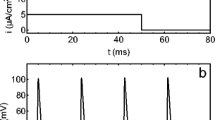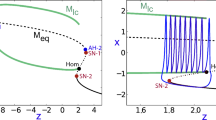Abstract
We measured the non-linear dynamics of cardiac action potentials by varying the stimulation frequency from 2 to 20 Hz and obtained the following results: (i) When the fast Na+ current initiated the action potentials (‘fast action potentials’) periodicity was maintained, i.e. the pattern of action potentials repeated after a finite number of stimuli. Chaotic sequences were absent. The transition from one sequence to the next occurred as a devil's staircase. (ii) When, however, the slow Ca2+ current initiated the action potentials (‘slow action potentials’), we observed chaos, i.e. fully irregular behaviour, as well as bifurcations. (iii) Our results confirm the supposition that the global dynamics of cardiac cells can be well described by simple one-dimensional maps which predict these two kinds of behaviour.
Similar content being viewed by others
References
Arnold VI (1983) Geometrical methods in the theory of ordinary differential equations. Springer, Berlin Heidelberg New York
Atwater I, Dawson CM, Scott A, Eddlestone G, Rojas E (1980) The nature of the oscillatory behaviour in electrical activity for pancreatic β-cell. In: Biochemistry biophysics of the pancreatic β-cell. Thieme, New York, pp 100–107
Attwell D, Cohen I, Eisner DA (1981) The effects of heart rate on the action potential of guinea-pig and human ventricular muscle. J Physiol 313:439–461
Babloyantz A, Salazar JM, Nicolis C (1985) Evidence of chaotic dynamics of brain activity during the sleep cycle. Phys Lett 111A:152–156
Beeler GW, Reuter H (1977) Reconstruction of the action potential of ventricular myocadial fibres. J Physiol 268:177–210
Bélair J (1986) Periodic pulsatile stimulation of nonlinear oscillator. J Math Biol 24:217–232
Bélair J, Glass L (1985) Universality and self-similarity in the bifurcations of circle maps. Physica 16D:143–154
Chay TR (1985) Chaos in a three-variable model of an excitable cell. Physica 16D:233–242
Chay TR, Lee YS (1985) Phase resetting and bifurcation in the ventricular myocardium. Biophys J 47:641–651
Clay J, DeFelice L, DeHaan R (1979) Current noise parameters derived from voltage noise and impedance in embryonic heart cell aggregates. Biophys J 28:169–184
Clay JR, Guevara MR, Shrier A (1984) Phase resetting of the rhythmic activity of embryonic heart cell aggregates. Biophys J 45:699–714
Colizza D, Guevara MR, Shrier A (1983) A comparative study of collagenase-and trypsin-dissociated embryonic heart cells: reaggregation, electrophysiology, and pharmacology. Can J Physiol Pharmacol 61:408–419
Connor JA (1985) Neuronal pacemakers and rhythmicity. Ann Rev Physiol 47:17–28
Cranefield P, Witt A (1979) Cardiac arrhythmias. Ann Rev Physiol 41:459–472
De Bruin G, Ypey DL, Van Meerwijk WPM (1983) Synchronization in chains of pacemaker cells by phase resetting action potential effects. Biol Cybern 48:175–186
DeHaan R, DeFelice L (1978) Oscillatory properties and excitability of the heart cell membrane. In: Theoretical chemistry: advances and perspectives. Academic Press, New York, pp 181–233
Eckmann JP (1981) Roads to turbulence in dissipative dynamical systems. Rev Mod Phys 53:643–654
Fabiato A, Fabiato F (1979) Calcium and cardiac excitation-contraction coupling. Ann Rev Physiol 41:473–484
Feigenbaum M (1978) Quantitative universality for a class of non-linear transformations. J Stat Phys 19:25–52
Glass L, Guevara MR, Shrier A (1983) Bifurcation and chaos in a periodically stimulated cardiac oscillator. Physica 7D:89–101
Glass L, Guevara MR, Bélair J, Shrier A (1984) Global bifurcations of a periodically forced biological oscillator. Phys Rev A 29:1348–1357
Goldberger AL, Bhargava V, West BJ, Mandell AJ (1985) Non-linear dynamics of the heartbeat. II: Subharmonic bifurcations of the cardiac interbeat intervals in sinus node disease. Physica 17D:207–214
Grassberger P, Procaccia I (1983) Measuring the strangeness of strange attractors. Physica 9D:189–208
Guevara MR, Glass L (1982) Phase locking, period doubling bifurcations and chaos in a mathematical model of a periodically driven oscillator: a theory for the entrainment of biological oscillators and the generation of cardiac dysrhythmias. J Math Biol 14:1–23
Guevara MR, Glass L, Shrier A (1981) Phase locking, period-doubling bifurcations, and irregular dynamics in periodically stimulated cardiac cells. Science 214:1350–1353
Guevara MR, Glass L, Mackey MC, Shrier A (1983) Chaos in neurobiology. IEEE Trans Syst Man Cybern SMC-13:790–798
Haken H (1985) Complex systems-operational approaches in neurobiology, physics and computers. Springer, Berlin Heidelberg New York
Hamill OP, Marty A, Neher E, Sakmann B, Sigworth J (1981) Improved patch-clamp technique for high resolution current recording from cells and cell-free membrane patches. Pflügers Arch 391:85–100
Hescheler J, Kameyama M, Trautwein W (1986) On the mechanism of muscarinic inhibition of the cardiac Ca-current Pflügers Arch 407:182–189
Hille B (1984) Ionic channels of excitable membranes. Sinauer, Sunderland
Holden AV (1982) Effects of tetraethylammonium and 4-aminopyradine on the somatic potential of an identified molluscan neuron. Comp Biochem Physiol 73A:303–310
Holden AV, Winlow W, Haydon PG (1983) The induction of perodic and chaotic activity in a molluscan neurone. Biol Cybern 43:169–173
Honerkamp J (1983) The heart as a system of coupled nonlinear oscillators. J Math Biol 18:69–88
Isenberg G, Klöckner U (1982a) Calcium tolerant ventricular myocytes prepared by preincubation in a ‘KB medium’. Pflügers Arch 395:6–18
Isenberg G, Klöckner U (1982b) Isolated bovine ventricular myocytes: Characterization of the action potential. Pflügers Arch 395:19–29
Jensen JH, Christiansen PL, Scott AC, Skovgaard O (1984) Chaos in the Beeler-Reuter system for the action potential of ventricular myocardial fibres. Physica 13D:269–277
Keener JP (1980) Chaotic behaviour in piecewise continuous difference equations. Trans Am Math Soc 261:589–604
Lebrun P, Atwater I (1985) Chaotic and irregular bursting electrical activity in mouse pancreatic β-cells. Biophys J 48:529–531
MacKay RS, Tresser C (1986) Transition to topological chaos for circle maps. Physica 19D:206–237
Matsumoto G, Aihara K, Hanyu Y, Takahashi N, Yoshizawa S, Nagumo J (1987) Chaos and phase locking in normal squid axons. Phys Lett 123A:162–166
Nobel D (1986) Ionic mechanics controlling the action potential duration and the timing of the repolarization, Jpn Heart J 27:[Suppl] 3–19
Ott E (1981) Strange attractors and chaotic motions of dynamical systems. Rev Mod Phys 53:655–671
Rajasekar S, Lakshmanan M (1988) Period-doubling bifurcations, chaos, phase-locking and devil's staircase in a Bonhoeffer-Van der Pol oscillator. Physica 32D:146–152
Rapp PE, Zimmerman ID, Albano AM, Deguzman GC, Greenbaun NN (1985) Dynamics of spontaneous neural activity in the simian motor cordex: the dimension of chaotic neurons, Phys Lett 110A:335–338
Sherman A, Rinzel J, Keizer J (1988) Regularization of bursting in pancreatic beta cells by cannel sharing. Biophys J 53: W-Pos 113
Spear J, Moore E (1982) Mechanisms of cardiac arrhythmias. Ann Rev Physiol 44:485–497
Strittmatter W, Honerkamp J (1984) Fibrillation of a cardiac region and the tachycardia mode of a two-oscillator system. J Math Biol 20:171–184
West J, Goldberger AL, Rovner G, Bhargava V (1985) Nonlinear dynamics of the heartbeat. I. The AV junction: passive conduit or active oscillator. Physica 17D:198–206
Wolf A, Swift JB, Swinney HL, Vastano JA (1985) Determining Lyapunov exponents from a time series. Physica 16D:285–317
Author information
Authors and Affiliations
Rights and permissions
About this article
Cite this article
Hescheler, J., Speicher, R. Regular and chaotic behaviour of cardiac cells stimulated at frequencies between 2 and 20 Hz. Eur Biophys J 17, 273–280 (1989). https://doi.org/10.1007/BF00254284
Received:
Accepted:
Issue Date:
DOI: https://doi.org/10.1007/BF00254284




